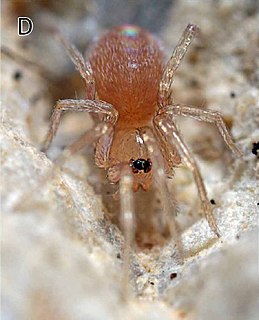
Oonopidae, also known as goblin spiders, is a family of spiders consisting of over 1,600 described species in about 113 genera worldwide, with total species diversity estimated at 2000 to 2500 species. The type genus of the family is OonopsKeyserling, 1835.

Ant spiders are members of the family Zodariidae. They are small to medium-sized eight-eyed spiders found in all tropical and subtropical regions of South America, Africa, Madagascar, Australia-New Guinea, New Zealand, Arabia and the Indian subcontinent. Most species are daytime hunters and live together with ants, mimicking their behavior and sometimes even their chemical traits. Although little is known about most zodariids, members of the genus Zodarion apparently feed only on ants; a number of other genera in the family are apparently also ant specialists.
Colima is a genus of spiders in the family Zodariidae, found in the state of Colima, Mexico.
Hermippus is a genus of ant eating spiders in the family Zodariidae, containing twelve species restricted to Asia and parts of Africa. Three new species were discovered in 2014.

Asceua is a genus of Asian ant spiders first described by Tamerlan Thorell in 1887.
Asteron is a genus of spiders in the family Zodariidae. It was first described in 1991 by Jocqué. As of 2017, it contains 8 Australian species.

Australutica is a genus of spiders in the family Zodariidae. It was first described in 1995 by Jocqué. As of 2017, it contains 6 species.
Cavasteron is a genus of spiders in the family Zodariidae. It was first described in 2000 by Baehr & Jocqué. As of 2017, it contains 12 species, all from Australia.
Dusmadiores is a genus of spiders in the family Zodariidae. It was first described in 1987 by Jocqué. As of 2017, it contains 6 species.
Euryeidon is a genus of spiders in the family Zodariidae. It was first described in 2004 by Dankittipakul & Jocqué. As of 2017, it contains 6 species, all from Thailand.
Heliconilla is a genus of spiders in the family Zodariidae. It was first described in 2012 by Dankittipakul, Jocqué & Singtripop. As of 2017, it contains 9 Asian species.
Heradida is a genus of spiders in the family Zodariidae. It was first described in 1893 by Simon. As of 2017, it contains 7 African species.
Leprolochus is a genus of spiders in the family Zodariidae. It was first described in 1893 by Simon. As of 2017, it contains 7 South American species.
Neostorena is a genus of spiders in the family Zodariidae. It was first described in 1914 by Rainbow. As of 2017, it contains 7 species from Australia.
Pentasteron is a genus of spiders in the family Zodariidae. It was first described in 2001 by Baehr & Jocqué. As of 2017, it contains 8 Australian species.
Tropizodium is a genus of spiders in the family Zodariidae. It was first described in 2005 by Jocqué & Churchill. As of 2017, it contains 9 species.
Trygetus is a genus of spiders in the family Zodariidae. It was first described in 1882 by Simon. As of 2017, it contains 7 species.
Suffrica is a genus of spiders in the family Zodariidae. It was first described in 2015 by Henrard & Jocqué. As of 2017, it contains 3 species from Kenya and Tanzania.
Nosterella is a genus of spiders in the family Zodariidae. It was first described in 2017 by Baehr & Jocqué. As of 2017, it contains 6 Australian species.



